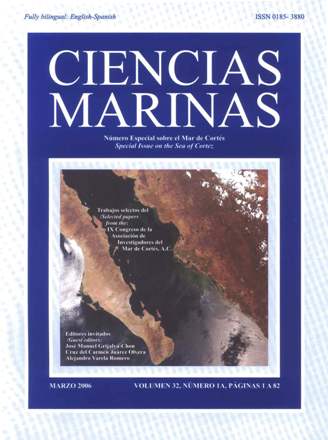Vertical flux of particulate matter in Alfonso Basin, La Paz Bay, during 2002.
Main Article Content
Abstract
Every three months during 2002, a 1/8-m2 Technicap PPS-3 time-series sediment trap was moored 50 m above the bottom of Alfonso Basin and provided 7–8 day resolution. Under the dissecting microscope, marine snow was abundant, while fecal pellets varied in number, size (0.25–10 mm) and form. Centric diatoms were common year-round, while chain-forming diatoms were clearly abundant only during a two-week period in June. The bulk samples were sieved (1 mm) to remove swimmers, the most frequent being polychaetes and pteropods, followed by gelatinous organisms and, rarely, crustaceans. The material was separated into ten equal parts using a rotary splitter. Four of the splits were rinsed of seawater, dried and weighed to determine the total mass flux. This varied between 0.17 and 2.48 g m–2 d–1. The highest fluxes occurred in February and the lowest in mid- April and late June. The average mass flux (300 g m–2 yr–1) is equivalent to a sediment accumulation rate of 0.4 mm yr–1, similar to that obtained from the dating of sediment cores from the basin. The carbonate fraction, determined by coulometry of the carbon content before and after acidification, was considerable, accounting for 8–26% of the total. The mean (14.6%) is similar to the concentration reported for surficial sediments. Peak concentrations occurred during periods in January, March, May, October and November. The CaCO3 flux averaged 0.128 g m–2 d–1, ranged between 0.036 and 0.304 g m–2 d–1 and was most intense in autumn and winter. The total mass and carbonate fluxes in La Paz Bay are considerably greater than those observed in Guaymas Basin, in the open Gulf of California.
Downloads
Article Details
This is an open access article distributed under a Creative Commons Attribution 4.0 License, which allows you to share and adapt the work, as long as you give appropriate credit to the original author(s) and the source, provide a link to the Creative Commons license, and indicate if changes were made. Figures, tables and other elements in the article are included in the article’s CC BY 4.0 license, unless otherwise indicated. The journal title is protected by copyrights and not subject to this license. Full license deed can be viewed here.

